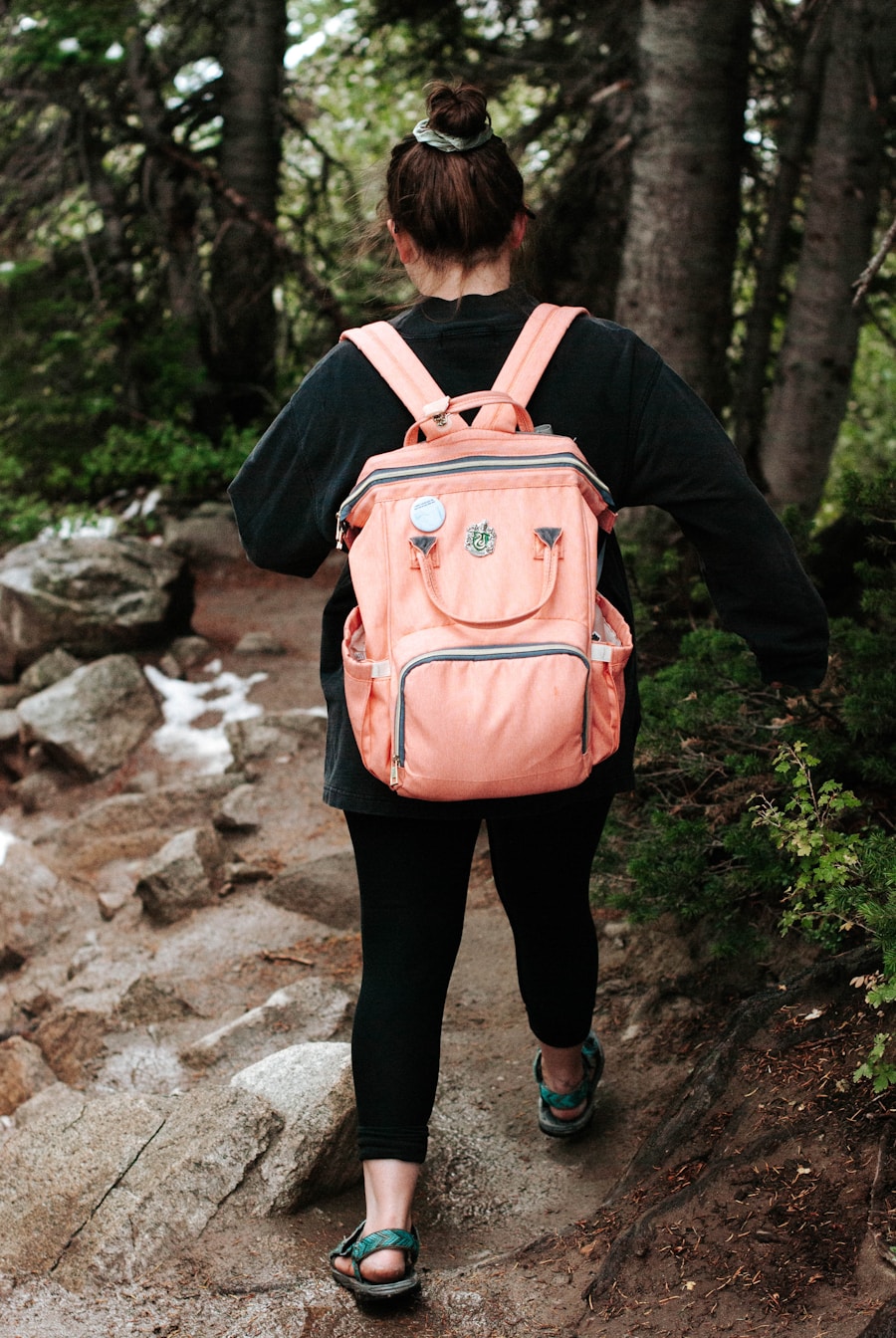Selecting the appropriate backpack size is a fundamental step in ensuring comfort and functionality during any outdoor adventure. The size of a backpack is typically measured in liters, with smaller packs ranging from 20 to 40 liters, ideal for day hikes or short trips, while larger packs can exceed 70 liters, suitable for extended excursions. When choosing a backpack, it is essential to consider the duration of your trip and the amount of gear you plan to carry.
For instance, a weekend camping trip may require a pack in the 50-70 liter range to accommodate sleeping bags, tents, and cooking equipment, while a day hike might only necessitate a 20-30 liter pack for water, snacks, and a first-aid kit. In addition to volume, the fit of the backpack is crucial. A well-fitted backpack should align with your torso length, which can vary significantly among individuals.
To determine your torso length, measure from the base of your neck to the top of your hip bones. Many manufacturers provide sizing charts that correlate torso length with specific backpack sizes. A pack that is too large can lead to instability and discomfort, while one that is too small may not accommodate all necessary gear.
Therefore, trying on various models and sizes while loaded with weight can help ensure that you find the perfect fit for your body type and intended use.
Key Takeaways
- Choose the right backpack size to ensure it can comfortably carry your gear without being too bulky or too small.
- Adjust shoulder straps and hip belt to distribute weight evenly and prevent strain on your back and shoulders.
- Properly distribute weight in your backpack to maintain balance and prevent discomfort during your hike.
- Pack your backpack efficiently to ensure easy access to essential items and prevent unnecessary strain on your body.
- Fit and adjust the sternum strap to keep shoulder straps in place and prevent them from slipping off during your hike.
Adjusting the Shoulder Straps and Hip Belt
Adjusting the Shoulder Straps
When adjusting the straps, ensure they are positioned correctly on your shoulders. The straps should distribute weight evenly across your shoulders without digging into your skin.
The Importance of the Hip Belt
The hip belt plays a critical role in weight distribution, sitting comfortably on your hips and ideally resting on the top of your hip bones. When properly adjusted, the hip belt should take on a significant portion of the pack’s weight, relieving pressure from your shoulders. To adjust the hip belt, tighten it until it feels secure but not restrictive; you should still be able to move freely without feeling constricted.
Ensuring a Comfortable Fit
Many backpacks come with padded hip belts that enhance comfort and help stabilize the load. Ensuring that both the shoulder straps and hip belt are adjusted correctly can significantly improve your overall experience while hiking or traveling.
Distributing Weight Properly

Effective weight distribution within your backpack is essential for maintaining balance and reducing fatigue during long treks. The general rule of thumb is to place heavier items closer to your back and higher up in the pack. This positioning helps maintain your center of gravity, allowing for better stability as you navigate uneven terrain.
For example, if you are carrying a tent or cooking gear, these items should be positioned near your back panel rather than at the bottom of the pack. Conversely, lighter items such as clothing or sleeping bags can be placed lower down or in external pockets. Additionally, utilizing various compartments and pockets within your backpack can aid in weight distribution.
Many modern backpacks feature multiple compartments designed for specific gear types, such as hydration reservoirs or quick-access pockets for snacks and maps. By organizing your gear effectively, you can prevent shifting during movement and ensure that essential items are easily accessible. It’s also beneficial to periodically reassess your load throughout your journey; as you consume food and water, the weight distribution may change, necessitating adjustments to maintain comfort and balance.
Packing the Backpack for Comfort and Efficiency
| Item | Weight (lbs) | Volume (cubic inches) |
|---|---|---|
| Sleeping Bag | 3.5 | 2500 |
| Tent | 5.2 | 10000 |
| Clothing | 6.8 | 4000 |
| Food | 10.5 | 6000 |
| Water | 8.0 | 12000 |
Packing your backpack efficiently not only enhances comfort but also maximizes space utilization. Start by laying out all your gear before packing; this allows you to visualize what you need and helps prevent overpacking. Begin with larger items such as sleeping bags or tents at the bottom of the pack, as they provide a stable base.
Next, add heavier items like cooking equipment or food close to your back for optimal weight distribution. This arrangement helps keep your center of gravity aligned with your body, reducing strain on your back and shoulders. In addition to strategic placement of heavy items, consider using packing cubes or compression sacks to organize smaller gear.
These tools can help compress clothing or sleeping bags into manageable sizes while keeping them organized within your pack. Furthermore, utilizing external attachment points on your backpack can free up internal space; items like trekking poles or sleeping pads can often be secured outside the pack for easy access. By taking time to pack thoughtfully, you can enhance both comfort during your hike and efficiency in accessing necessary gear.
Properly Fitting and Adjusting the Sternum Strap
The sternum strap is an often-overlooked component of a backpack that plays a vital role in stabilizing the load across your chest. When properly fitted, it helps keep the shoulder straps in place and prevents them from sliding off your shoulders during movement. To adjust the sternum strap, position it across your chest at a comfortable height—typically around the middle of your sternum—and tighten it until it feels secure but not constricting.
This adjustment allows for better weight distribution and reduces strain on your shoulders. In addition to providing stability, a well-adjusted sternum strap can enhance overall comfort by allowing for greater freedom of movement in your arms. If you find that the strap is too tight or restrictive while reaching for items in your pack or using trekking poles, consider loosening it slightly until you find a balance between support and mobility.
Some backpacks even feature adjustable sternum straps that allow you to customize their height based on personal preference or body type.
Adjusting the Load Lifters for Proper Weight Distribution

Load lifters are an essential feature found on many backpacks designed for hiking and trekking. These straps connect the top of the shoulder straps to the back panel of the pack and are crucial for adjusting how weight is distributed between your shoulders and hips. When properly adjusted, load lifters help pull the top of the pack closer to your body, which enhances stability and reduces strain on your back during movement.
To adjust load lifters effectively, first ensure that your shoulder straps are correctly fitted. Then, pull on the load lifter straps until you feel a slight tension; this should bring the top of the pack closer to your back without causing discomfort or restricting movement. The ideal angle for load lifters is typically around 45 degrees from horizontal; this positioning helps maintain an optimal center of gravity while allowing for natural movement as you hike.
Regularly checking and adjusting load lifters throughout your journey can help maintain comfort and prevent fatigue.
Using Compression Straps to Secure the Load
Compression straps are another valuable feature found on many backpacks that serve multiple purposes in enhancing comfort and stability during outdoor activities. These straps are typically located on the sides or front of a backpack and can be tightened to compress the load within the pack. By securing loose items and minimizing excess movement within the pack, compression straps help maintain balance while hiking over uneven terrain.
When using compression straps, it’s important to ensure that they are tightened enough to keep items secure without overly constricting them. Over-tightening can lead to discomfort or damage to fragile gear such as sleeping bags or clothing. Additionally, compression straps can be used strategically to create additional storage space; if you have extra gear that doesn’t fit inside your pack, these straps can often accommodate items like jackets or sleeping pads externally without compromising stability.
Ensuring Proper Ventilation and Airflow for Comfort
Ventilation is a critical aspect of backpack design that significantly impacts comfort during long hikes or treks in warm weather conditions. Many modern backpacks incorporate mesh panels or ventilated back systems designed to promote airflow between your back and the pack itself. This feature helps reduce sweat buildup and keeps you cooler during strenuous activities.
When selecting a backpack, consider models with adjustable ventilation systems that allow you to customize airflow based on weather conditions or personal preference. Additionally, wearing moisture-wicking clothing can complement these ventilation features by helping manage sweat more effectively. Ensuring proper ventilation not only enhances comfort but also contributes to overall performance by preventing overheating during challenging hikes or extended periods of activity.
By paying attention to these various aspects of backpack fitting and packing techniques, outdoor enthusiasts can significantly enhance their hiking experience. Each adjustment contributes not only to comfort but also to safety and efficiency on the trail, allowing adventurers to focus on enjoying nature rather than battling discomfort or fatigue from improper gear management.
If you’re planning a hiking trip and want to make sure you’re wearing your backpack correctly, be sure to check out this helpful article on how to wear a hiking backpack. This guide will provide you with tips and tricks to ensure your backpack is comfortable and properly fitted for your outdoor adventure.
FAQs
What should I consider when choosing a hiking backpack?
When choosing a hiking backpack, consider the capacity, fit, features, and comfort. The capacity should be appropriate for the length of your hikes and the gear you need to carry. The fit should be comfortable and adjustable to your body size. Look for features such as multiple compartments, hydration compatibility, and durable materials. Comfort is key, so make sure the backpack has padded straps and a supportive hip belt.
How should I pack a hiking backpack?
When packing a hiking backpack, place heavier items closer to your back and towards the bottom of the pack. Lighter items can go towards the top and outside pockets. Keep frequently used items easily accessible and distribute the weight evenly to maintain balance. Use compression straps to secure the load and prevent shifting while hiking.
What are some tips for wearing a hiking backpack?
When wearing a hiking backpack, adjust the shoulder straps and hip belt to distribute the weight evenly and comfortably. Make sure the backpack sits close to your body and the hip belt rests on your hips. Use the sternum strap to prevent the shoulder straps from slipping off. Keep the load balanced and walk with an upright posture to reduce strain on your back.
How do I adjust the straps on a hiking backpack?
To adjust the straps on a hiking backpack, start by loosening all the straps. Put the backpack on and tighten the hip belt first, so it rests on your hips. Then adjust the shoulder straps, making sure they are snug but not too tight. Finally, adjust the load lifters, which are the straps that connect the top of the shoulder straps to the top of the backpack, to pull the weight closer to your body.
What are some common mistakes to avoid when wearing a hiking backpack?
Common mistakes to avoid when wearing a hiking backpack include overpacking, wearing the backpack too low or too high on your back, not adjusting the straps properly, and neglecting to distribute the weight evenly. It’s also important to avoid carrying unnecessary items and to regularly check and maintain the backpack for any wear and tear.
